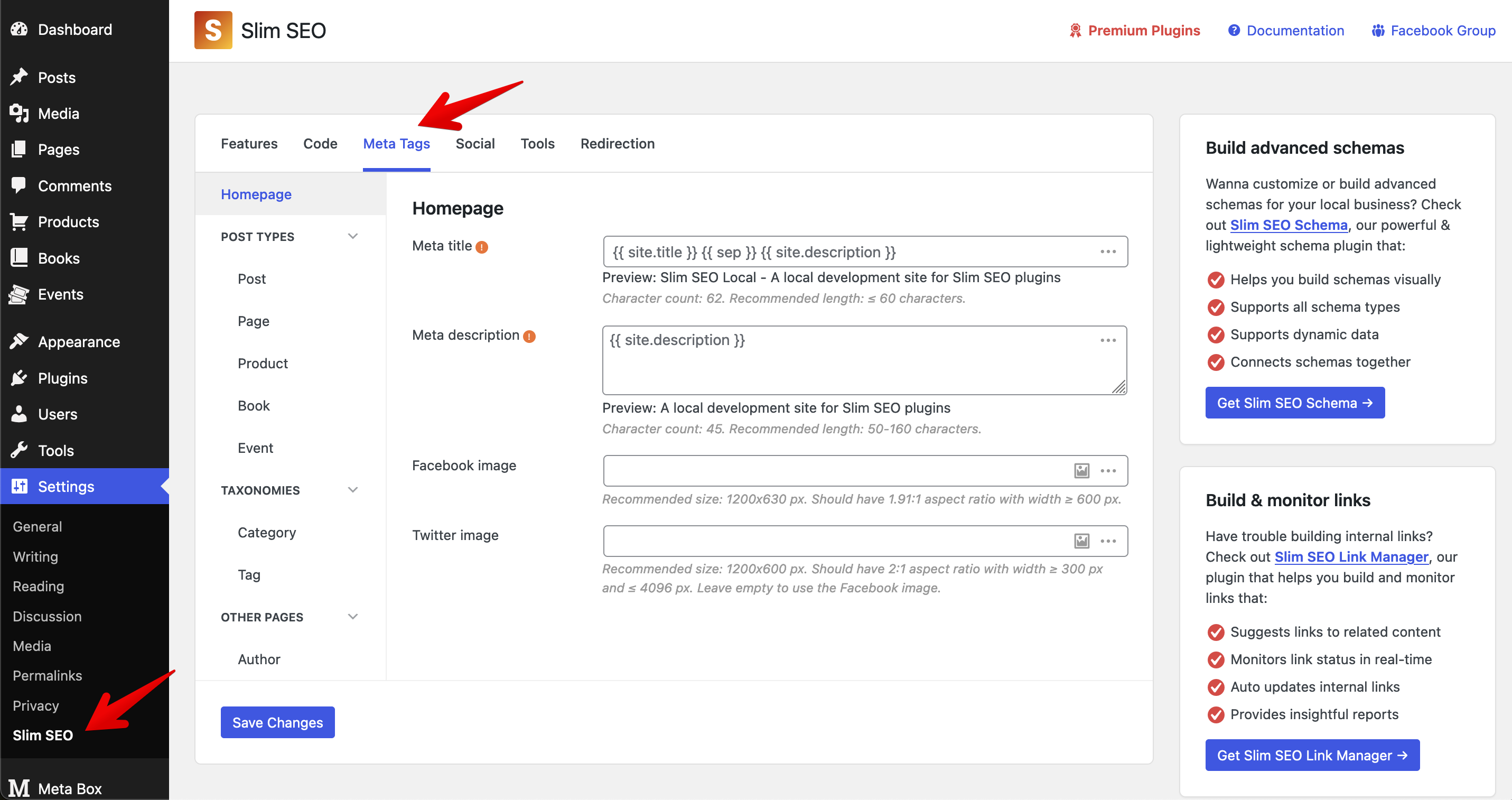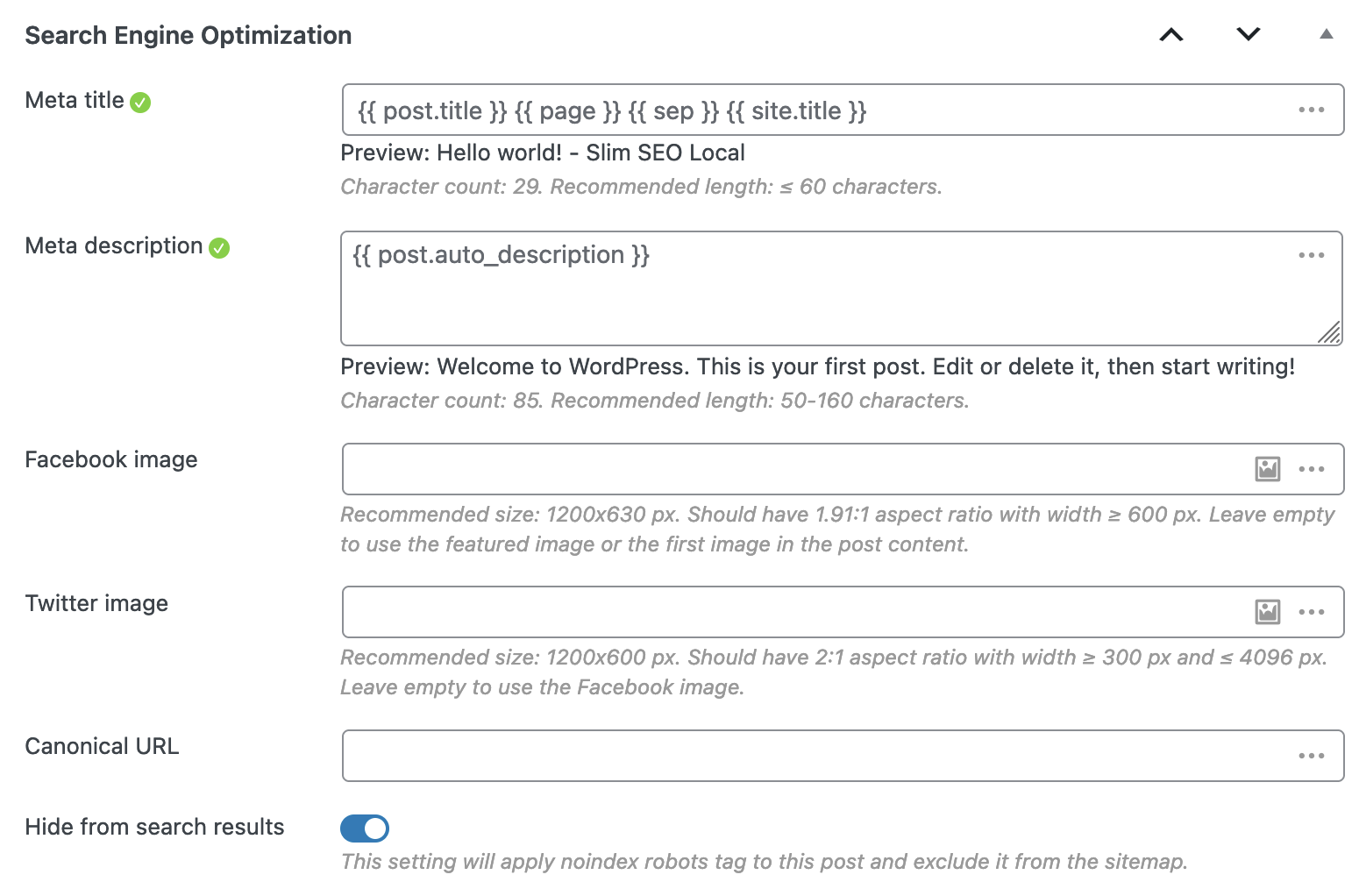Meta Title Tag
You don't need to configure meta title tag. WordPress already has this featured! All we need to do is add theme support for title-tag.
add_theme_support( 'title-tag' );
We already do that hundreds times while coding themes. And WordPress does its job pretty well.
So, with Slim SEO, this feature is automatically enabled.
The title tag will have the following format:
- For homepage: Site title – Site description
- For singular pages/posts: Page/Post title – Site title
- For other pages: Page title – Site title
How to set up meta title for post types and taxonomies?
If you want to set up meta title format for custom post types, please go to Settings > Slim SEO and select the Meta Tags tab. There you will see a list of available post types and taxonomies, and you can configure the meta tags for them.

The plugin provides dynamic variables to help you configure the meta tags easier. Please refer to this docs for more details.
How to change meta title manually?
If you want to set custom meta title for a specific post or term, simply enter the text in the Search Engine Optimization meta box below the content area:

You'll see the status icon showing if the description has a good length. The meta title should not be longer than 60 characters. You can also use dynamic variables here.
Slim SEO supports shortcodes in the meta title and meta description, you can add your own shortcodes here to output your custom dynamic content.
When you enter the manual meta title, it'll be used as it is. It won't be appended with the site title.
If you set your homepage as a static page, then the plugin treats it like a normal page. SEO settings for the homepage won't be available in the plugin settings (Settings > Slim SEO). Instead, they will be available below the editor when you edit the homepage.
How to change the meta title with code?
If you want to change the title, please use the slim_seo_meta_title filter.
The following code changes the meta title for a single post with ID = 24. The title is get via a custom field:
add_filter( 'slim_seo_meta_title', function( $title, $object_id ) {
if ( get_post_type( $object_id ) === 'movie' ) {
$title = get_post_meta( $object_id, 'movie_title', true );
}
return $title;
}, 10, 2 );
Note that using filter will have the highest priority, e.g. it will overwrite the meta title you enter manually. To avoid that, you can check if the post has manual meta title and change the title only when it doesn't:
add_filter( 'slim_seo_meta_title', function( $title, $object_id ) {
if ( get_post_type( $object_id ) === 'movie' ) {
// Detect if a single post has manual meta title.
$meta = get_post_meta( $object_id, 'slim_seo', true );
if ( ! empty( $meta['title'] ) ) {
return $meta['title'];
}
$title = get_post_meta( $object_id, 'movie_title', true );
}
return $title;
}, 10, 2 );
How to change the separator in the meta title?
By default, WordPress uses a dash (-) as the separator in the meta title. To change that, please use this snippet:
add_filter( 'document_title_separator', function() {
return '|'; // Replace with your custom separator.
} );
How to hide SEO columns
By default, the plugin shows custom meta title and meta description in the admin post and term table. There are two ways to hide these columns:
Toggle the screen options
Click the Screen Options button at the top right corner of the screen and toggle the checkboxes for Meta title and Meta description:

This way, you show or hide the columns for the current user only. It's not applied to all users.
Hide the columns with code
To hide the columns completely for all users, please use this snippet:
add_filter( 'slim_seo_admin_columns_post', '__return_empty_array' );
add_filter( 'slim_seo_admin_columns_term', '__return_empty_array' );
How to hide SEO settings meta box for non-admin users?
In some cases, where you want only admins can change the meta title, meta description or other SEO settings, then use this snippet to hide the SEO settings meta box from other user roles:
// Hide SEO settings meta box for posts.
add_filter( 'slim_seo_meta_box_post_types', function ( $post_types ) {
return current_user_can( 'manage_options' ) ? $post_types : [];
} );
// Hide SEO settings meta box for terms.
add_filter( 'slim_seo_meta_box_taxonomies', function ( $taxonomies ) {
return current_user_can( 'manage_options' ) ? $taxonomies : [];
} );
Please note that if SEO settings meta box is hidden, then users won't see the SEO columns in the post/term list table neither.